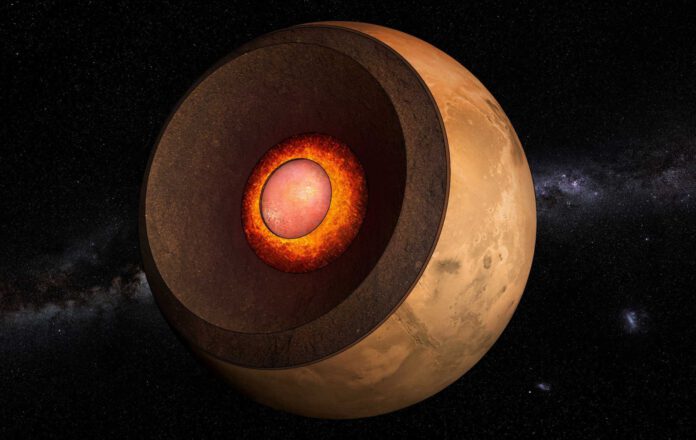
The metallic core of Mars is not only smaller and denser than previously thought, but it also appears to be enveloped by magma. These discoveries have led to new insights into how Mars was formed and evolved to become the seemingly uninhabitable planet we know today.
The InSight Mars lander
For four years, the InSight Mars lander has studied the inner workings of our neighboring planet, Mars. During this time, the lander collected a plethora of data that researchers are still sifting through. A new analysis of the recorded Marsquakes, combined with computer models, has now drawn a completely new picture of the planet’s core. This has led to new information about how Mars has evolved over time and why it is no longer suitable to support life.
An Unexpected Discovery
While scientists were diligently analyzing InSight’s data, they made an unexpected discovery. The data suggested that the Martian core is surrounded by a 150-kilometer thick layer of liquid silicate (also known as magma). The top of this layer was previously incorrectly interpreted as the surface of the core. The thick layer lies exactly between Mars’ liquid iron core and solid silicate mantle. “Earth does not have a fully melted silicate layer like this,” said researcher Amir Khan.
The Core: Smaller and Denser
The discovery of this layer of magma suggests that Mars’ core is significantly smaller and denser than believed. It was previously hypothesized that Mars’ core had a diameter of somewhere between 1,800 and 1,850 kilometers. Now, scientists have revised this estimate to about 1,650-1,700 kilometers, which is roughly half of Mars’ radius. This also means that Mars’ core contains fewer light elements, decreasing by somewhere between 9 and 14 percent of the total weight. Despite this reduction, Mars still harbors many light elements such as sulfur, carbon, oxygen, and hydrogen. The presence of substantial light elements in the core suggests it formed very early in Mars’ history, perhaps when the sun was still surrounded by gas in which light elements could gather.
The Most Accurate Estimates Yet
The results provide the most detailed and accurate estimates yet of Mars’ core and mantle structure. These results suggest that our understanding of how terrestrial planets are formed and what makes them up is improving. However, the discovery of the thick magma layer doesn’t just change our view of Mars’ deep interior.
Magnetic Field
Researcher Vedran Lekic likened the newly discovered molten layer to a ‘heating blanket’ covering Mars’ core. “This ‘blanket’ not only keeps the core warm and prevents it from cooling down but also ensures that radioactive elements generating heat when they decay are concentrated,” he explained. “When this happens, the core probably can’t create the currents necessary to generate a magnetic field. This could explain why Mars currently has no active magnetic field.”
Lack of Life
In essence, the insulating layer of magma effectively prevents the core from cooling down and generating a thermodynamo, which normally produces a magnetic field around planets like Earth. In the absence of a functioning protective magnetic field, a planet like Mars is extremely vulnerable to intense solar wind. All surface water also disappears, effectively extinguishing any hope of Mars supporting life.
External Factors
Still, we know that Mars once had a magnetic field. According to the researchers, external factors may be the cause. “The discovery of the liquid layer means external forces are needed to create the magnetic field Mars had during the first 500 to 800 million years of its evolution,” says lead author Henri Samuel. “These external forces could stem from powerful meteor impacts or movements in the core induced by gravitational interactions with now absent ancient moons.”
An Ocean of Magma
The findings confirm earlier proposed theories that Mars likely had an ocean of magma in the past. This solidified into a layer beneath the martian mantle made up of ‘silicate melt,’ containing iron and radioactive elements. The heat generated by the radioactive elements would then significantly influence Mars’ thermal evolution and cooling history. “If these layers are widespread, they could have significant consequences for other aspects of the planet,” says Lekic. “These layers could help us understand whether planets can create and maintain magnetic fields, how planets cool over time, and how the interior of planets changes over time.”
Continued Study
Although the InSight mission officially ended in December 2022, the analysis of the collected data continues, proving there is still much to discover. The mission has helped scientists gain a better understanding of Mars’ internal structure, including the dimensions and composition of its core, and provided global insights into the tumultuous way in which the planet was formed. “The recent discovery of a molten layer is just one example of how we’re continually learning from the concluded InSight mission,” says Lekic. Researchers are pleased with the outcome of the mission. “The InSight mission was extraordinarily successful and has provided us with a wealth of new data and insights,” adds Khan. “We will continue to analyze these over the coming years.”











